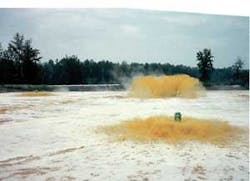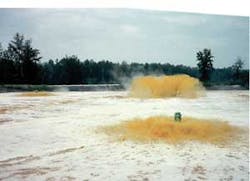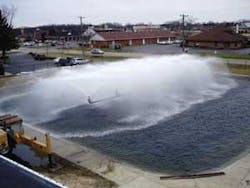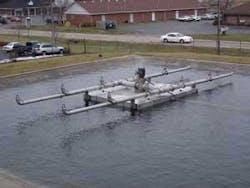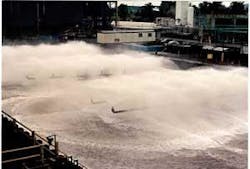Spray Cooling Advantages for Industrial Wastewater Applications
By Terry Johnson, P.E.
Siemens Water Technologies offers a look at three cases where this water cooling method was used – power plants, steel mills and paper mills.
Industrial plants must often cool high-temperature wastewater prior to biological treatment. Process water also may need cooling to reach permitted discharge levels or to cool intake process water.
Cooling towers are often used to dissipate the heat duty associated with these streams. Still, they have a higher initial cost, are more expensive to maintain and usually require chemicals for prevention and removal of scaling. Cooling ponds are another alternative but can require as much as 20 times the land space as ponds equipped with spray coolers or other spray cooling techniques, which may prove too expensive or impractical.
Floating spray coolers and surface aerators can provide evaporative cooling of industrial wastewater as an economic alternative or supplement to either cooling towers or cooling ponds. These mechanical cooling devices are quick and easy to install and don’t require chemical addition to prevent scaling or clogging. Both spray cooling options are even more cost-effective when existing ponds are available for equalization and cooling.
Spray Coolers vs. Surface Aerators
So when should spray coolers be used instead of surface aerators? Capital costs for a spray cooler tend to be greater than for a surface aerator, with a 75-hp spray cooler costing about five times as much as a surface aerator of the same horsepower. Applications that require a high rate of heat dissipation are good candidates for spray coolers. For applications with a relative low heat duty, spray coolers are too expensive and cannot be justified economically.
Some crossover does exist, however, depending on the application. The cooling capacity of surface aerators is about 10 times less than spray coolers for a given set of operating conditions. Therefore, surface aerators make sense for applications that are borderline in terms of operating temperature and only need a relatively small amount of cooling, particularly during summer operating conditions.
Similarly, paper mills sometimes require spray coolers ahead of their secondary wastewater treatment process to optimize biological treatment performance. In this case, biological treatment wouldn’t be possible downstream unless the water was first cooled below 95°F (35°C) ahead of secondary treatment.
How Spray Cooling Works
Spray cooling is a dynamic process that depends on site conditions that change from day-to-day and throughout any given day. Most of the heat removed in any spray cooling system is removed by evaporation. For instance, under summer operating conditions, 85-90% of cooling is achieved in this manner.
The primary purpose of a spray cooling device is heat dissipation. It’s difficult to generalize the heat dissipation capacity of any type of device since design conditions vary so widely. Wind velocities, wet and dry bulb temperatures, liquid flow, and liquid temperature all affect heat dissipation.
To calculate cooling performance, the basic design parameters of the wastewater system must be established. The maximum or design flow rate should first be determined. The critical design point is at maximum flow, maximum inlet temperature and maximum wet bulb temperature. If the cooling system performs under these conditions, then power consumption can be cut during less severe conditions. Unit size and multiple-unit design should be considered to achieve near optimum power savings as well as minimum capital costs.
In addition to the above, other factors affecting spray cooling efficiency include target effluent temperature, influent hot water temperature relative to the wet bulb, surface area of the spray, relative velocities of the air and water during contact, and contact time of the water droplets in the air.
Industrial Applications
Floating spray coolers and surface aerators can be used in pulp & paper mills, power plants, steel mills, food processing plants and other industrial applications to meet cooling requirements.
Floating spray coolers are an economic option for cooling process water or wastewater from industries, especially during peak loadings. The spray cooler concept employs a multiple nozzle assembly supported on a floating platform. A pump-manifold-nozzle design produces effective heat transfer while the floating platform offers quick, flexible installation. Heated water is sprayed many times into the air to achieve the desired heat dissipation, cooling the water to within about 9-10°F (-13 to -12°C) of the actual wet bulb temperature with continuous influent flow to the cooling pond.
Spray coolers provide the optimal design for peak heat transfer efficiently, with low power consumption (individual units can be cycled on/off to save energy) and less drift loss than with wet cooling towers.
Compared to cooling towers, capital costs for spray coolers are lower with existing ponds and operating costs are lower as chemical treatment is not needed to prevent bacteria growth. Spray cooler technology also does not provide an environment conducive to Legionella bacteria growth, which has been discovered inside cooling towers and released via the cooling tower mist. While spray coolers do require more land than wet cooling towers, their footprint is less than 5% of what cooling ponds consume.
null
When an energy plant in Canada installed eight 12-nozzle spray coolers in May 2005, it saved 20% over installing cooling towers. The spray coolers have helped to supplement the plant’s existing pond, as heat duty on the pond increased from expansion of the process.
Floating surface aerators typically provide oxygen transfer and mixing in biological treatment processes, yet can be modified to enhance cooling performance. Surface aerators’ powerful pumping action breaks wastewater up into a spray of particles, crea-ting more surface area for atmospheric pressure to drive oxygen into the wastewater. At the same time, oxygen-enriched water is dispersed and mixed, yielding effective wastewater treatment. Applications include aerated lagoons, stabilizations basins, sequencing batch reactors, activated sludge, aerobic digestion, and existing system upgrades.
Compared to cooling towers, operating costs for surface aerators are low. For example, a few surface aerator manufacturers offer motor bearings that don’t need to be lubricated for five years. In addition, surface aerators reduce effluent BOD, COD and color.
In May 2006, a Pennsylvania (USA) paper mill installed eight trimmed discharge cone aerators in two in-series cooling ponds ahead of activated sludge treatment. The 4.5-MGD plant has an influent temperature of 122°F (50°C) and an effluent temperature of less than 95°F (35°C). After installing the surface aerators, the industrial plant achieved effluent temperature requirements all summer. Final effluent BOD that summer was less than 10 mg/L; in previous years, it had been 15-20 mg/L. Effluent COD and color were also significantly reduced. The paper mill attributed the improved overall treatment to not just the cooling but also to the improved mixing and oxygen transfer in the cooling ponds.
Conclusion
Spray cooling is an effective means of dissipating heat in high-temperature industrial wastewater prior to biological treatment or final discharge. Floating spray coolers and surface aerators are just two types of spray cooling devices that can be used for such industrial applications as power plants, pulp & paper mills, steel mills, and food processing plants, to name a few.
These spray cooling techniques have several advantages over cooling towers and cooling ponds. Namely, they’re less costly to purchase and maintain, and don’t require regular addition of chemicals to prevent and remove scaling. Spray coolers also prevent Legionella bacteria growth, and surface aerators reduce effluent BOD, COD, and color. Both spray cooling options also can be used to supplement cooling towers and cooling ponds.
Author’s Note:
Terry Johnson, P.E., is the industrial sales engineer and product manager for the aerator product line at Siemens Water Technologies in Roscoe, Illinois, USA. Contact: +1-815-623-2111, [email protected] or www.industry.siemens.com/water/
